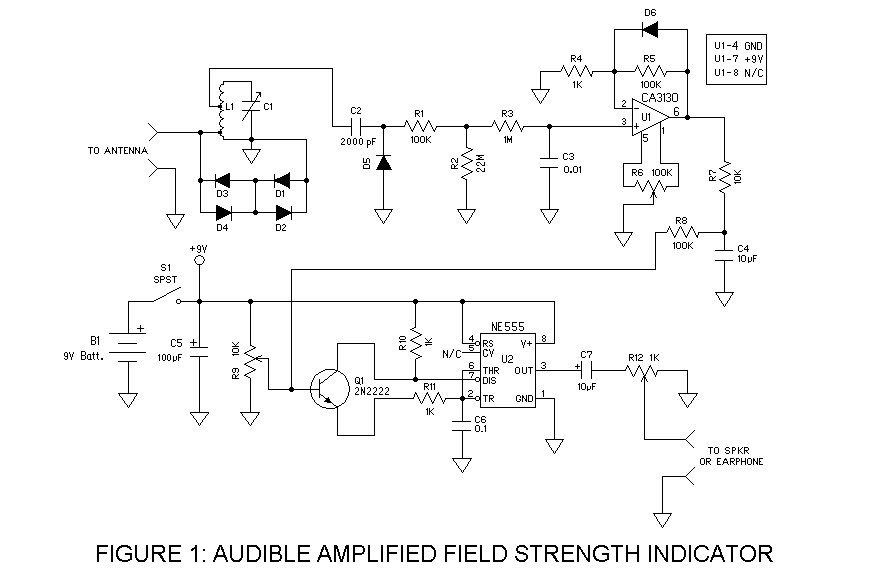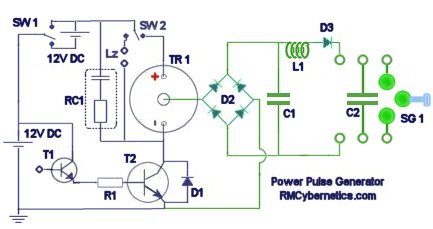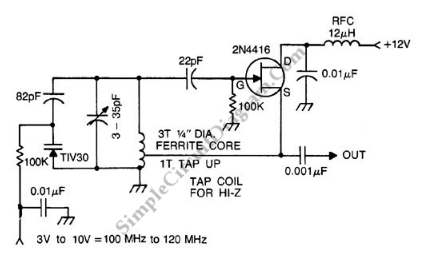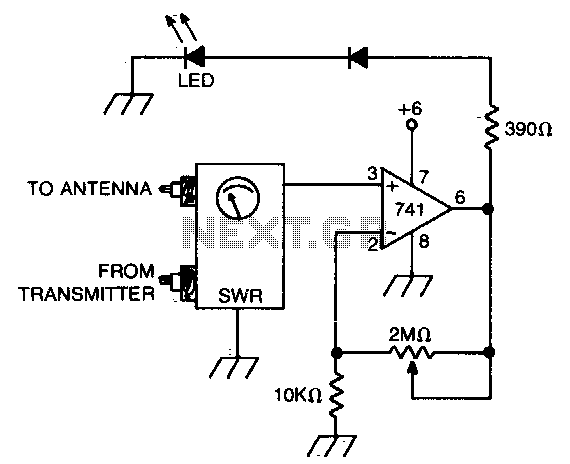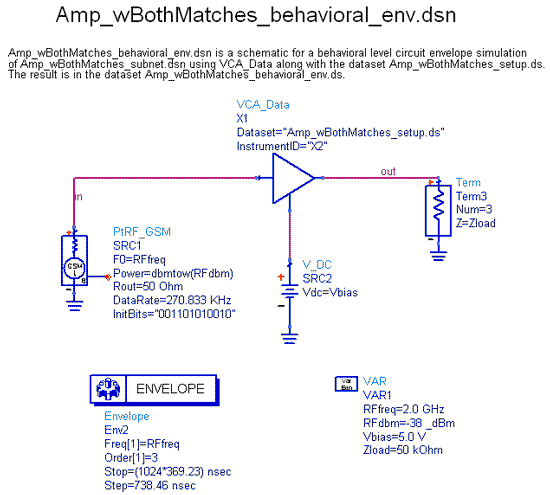
LM741 OpAmp Voltage Indicator
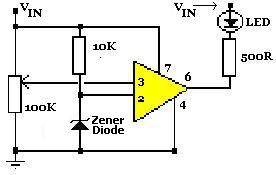
A simple voltage status monitor built around the LM741 operational amplifier. These circuits are recognized for their accuracy, ease of operation, and cost-effectiveness. The LM741 serves as an operational amplifier, widely used for various applications. The primary function of this circuit is to automatically turn an output voltage on (or off) when a measured voltage (e.g., from a battery) matches a user-defined reference voltage. The circuit diagram is configured to provide a high voltage indication, with an LED turning on when the measured input voltage exceeds a specified level. A 100 kΩ variable resistor allows manual adjustment of the voltage threshold for LED activation. When the reference voltage at pin 2 of the LM741 is lower than the battery voltage at pin 3 (derived through a voltage divider formed by the variable resistor), the output at pin 6 is low, causing the LED to illuminate. Conversely, if the reference voltage at pin 2 exceeds the battery voltage at pin 3, the output at pin 6 becomes high, resulting in the LED being off due to a lack of voltage across it. The Zener diode should be selected with a Zener voltage approximately half that of the target voltage; for a 12.0 Volt indicator, a 5.6 Volt Zener diode is suitable. For low voltage indication, the output from pin 6 is routed through an LED (with a current-limiting resistor) connected to ground (0V) instead of the positive input voltage (Vin). The output behavior remains the same as with the high voltage indicator: if the voltage at pin 2 is lower than at pin 3, the output at pin 6 is low, and if it is higher, the output is high. In this configuration, a high output from pin 6 activates the LED, providing a low voltage indication when the battery voltage at pin 3 is lower than the reference voltage at pin 2.
To set up the voltage indicator, it is recommended to use a variable power supply. A digital multimeter should be used to set the voltage to the desired LED activation level. After connecting the voltage source to the circuit, the 100 kΩ variable resistor can be adjusted until the LED just turns on or off, calibrating it to activate at that specific voltage. If a variable voltage source is not available, alternative methods must be employed to supply the desired reference voltage for calibration. For instance, to configure the LED to light up when a solar battery charger has fully charged batteries, fully charged batteries can be connected to the solar panel and then to the circuit while adjusting the 100 kΩ variable resistor. Similarly, to set the LED to illuminate when a 12V lead-acid battery is 25% discharged (with a terminal voltage of 12.00V), the battery should be allowed to discharge to that level before configuring the indicator circuit. Another option is to utilize a variable voltage regulator, such as an LM317, to achieve the desired threshold voltage for calibration.
This circuit exemplifies a practical application of the LM741 operational amplifier, providing an effective and cost-efficient solution for voltage monitoring in various battery systems. The design's simplicity and adaptability make it suitable for both hobbyist projects and more serious applications in battery management systems.A simple voltage status monitor built around the LM741 operational amplifier. These circuits are the best we have found in terms of accuracy, simplicity of operation, and cost. The LM741 is an operational amplifier. The wide range of uses of this simple and cheap integrated circuit do not need to be mentioned here - of importance is that an output voltage is turned on (or off) automatically when a measured voltage (e. g from a battery) reaches the same value as a reference voltage (manually set by the user). The circuit diagram shown above is configured to give a high voltage indication - LED turned on when the measured input voltage is above a certain level. The 100KOhm variable resistor is used to manually configure the voltage over and above which the LED will light.
If the reference voltage arriving at pin 2 of the LM741 is lower than the battery voltage arriving at pin 3 via the voltage divider created by the variable resistor, then the output from pin 6 of the LM741 will be low. Therefore the LED will turn on as it has voltage across it. If on the other hand the reference voltage on pin 2 is higher than the battery voltage on pin 3, the output from pin 6 will be high, and so as there is no voltage across the LED, it will be off.
The Zener diode should be chosen with a zener voltage of around half that of the target voltage - e. g. for a 12. 0 Volt indicator, a 5. 6 Volt Zener diode could be used. In order to obtain a low voltage indication - useful if you would like to stop using a battery before it is drained too deeply - the output from pin 6 is still directed through an LED (and current limiting resistor), but this time it is connected to ground (0V) rather than to the positive input voltage Vin as shown in the amended circuit diagram above. The output from the LM741 will still be the same as with the high voltage indicator described above: pin 2 voltage lower than pin 3 voltage results in a low output from pin 6, and pin 2 voltage higher than pin 3 voltage results in a high output from pin 6.
Since the LED now goes to ground, a high output from pin 6 sees it turn on, and therefore we have our low voltage indication with the battery voltage on pin 3 lower than the reference voltage on pin 2. NEW For an LM741-based circuit plan for a low voltage indicator specifically for a typical 12 Volt battery or battery bank, click here to read our article 12 Volt Low Battery Indicator - LM741.
In order to set up the voltage indicator a variable power supply unit should ideally be used. Using a digital multimeter set the voltage to the desired light up LED value, connect the voltage source to the circuit, and then turn the 100K variable resistor until the LED is just turning on/off. It is now configured to light up (or turn off) the LED at that exact voltage. If you do not have a variable voltage source - as is the case for most people - then you need to find a way to supply the desired reference voltage to the circuit for configuration.
If for example, you want to light up the LED when a solar battery charger has fully charged some batteries, connect fully charged batteries to the solar panel and then connect the whole thing to the circuit while you adjust the 100K variable resistor. Similarly if you want the LED to light up when a 12V lead acid battery is 25% discharged (i. e. you measure a terminal voltage of 12. 00V on the battery), then wait until your battery has discharged approximately this far and then set up the indicator circuit.
Another alternative is to use a variable voltage regulator such as an LM317 ( LM317 Adjustable Voltage Supply ) to get the desired threshold voltage for calibration of t 🔗 External reference
To set up the voltage indicator, it is recommended to use a variable power supply. A digital multimeter should be used to set the voltage to the desired LED activation level. After connecting the voltage source to the circuit, the 100 kΩ variable resistor can be adjusted until the LED just turns on or off, calibrating it to activate at that specific voltage. If a variable voltage source is not available, alternative methods must be employed to supply the desired reference voltage for calibration. For instance, to configure the LED to light up when a solar battery charger has fully charged batteries, fully charged batteries can be connected to the solar panel and then to the circuit while adjusting the 100 kΩ variable resistor. Similarly, to set the LED to illuminate when a 12V lead-acid battery is 25% discharged (with a terminal voltage of 12.00V), the battery should be allowed to discharge to that level before configuring the indicator circuit. Another option is to utilize a variable voltage regulator, such as an LM317, to achieve the desired threshold voltage for calibration.
This circuit exemplifies a practical application of the LM741 operational amplifier, providing an effective and cost-efficient solution for voltage monitoring in various battery systems. The design's simplicity and adaptability make it suitable for both hobbyist projects and more serious applications in battery management systems.A simple voltage status monitor built around the LM741 operational amplifier. These circuits are the best we have found in terms of accuracy, simplicity of operation, and cost. The LM741 is an operational amplifier. The wide range of uses of this simple and cheap integrated circuit do not need to be mentioned here - of importance is that an output voltage is turned on (or off) automatically when a measured voltage (e. g from a battery) reaches the same value as a reference voltage (manually set by the user). The circuit diagram shown above is configured to give a high voltage indication - LED turned on when the measured input voltage is above a certain level. The 100KOhm variable resistor is used to manually configure the voltage over and above which the LED will light.
If the reference voltage arriving at pin 2 of the LM741 is lower than the battery voltage arriving at pin 3 via the voltage divider created by the variable resistor, then the output from pin 6 of the LM741 will be low. Therefore the LED will turn on as it has voltage across it. If on the other hand the reference voltage on pin 2 is higher than the battery voltage on pin 3, the output from pin 6 will be high, and so as there is no voltage across the LED, it will be off.
The Zener diode should be chosen with a zener voltage of around half that of the target voltage - e. g. for a 12. 0 Volt indicator, a 5. 6 Volt Zener diode could be used. In order to obtain a low voltage indication - useful if you would like to stop using a battery before it is drained too deeply - the output from pin 6 is still directed through an LED (and current limiting resistor), but this time it is connected to ground (0V) rather than to the positive input voltage Vin as shown in the amended circuit diagram above. The output from the LM741 will still be the same as with the high voltage indicator described above: pin 2 voltage lower than pin 3 voltage results in a low output from pin 6, and pin 2 voltage higher than pin 3 voltage results in a high output from pin 6.
Since the LED now goes to ground, a high output from pin 6 sees it turn on, and therefore we have our low voltage indication with the battery voltage on pin 3 lower than the reference voltage on pin 2. NEW For an LM741-based circuit plan for a low voltage indicator specifically for a typical 12 Volt battery or battery bank, click here to read our article 12 Volt Low Battery Indicator - LM741.
In order to set up the voltage indicator a variable power supply unit should ideally be used. Using a digital multimeter set the voltage to the desired light up LED value, connect the voltage source to the circuit, and then turn the 100K variable resistor until the LED is just turning on/off. It is now configured to light up (or turn off) the LED at that exact voltage. If you do not have a variable voltage source - as is the case for most people - then you need to find a way to supply the desired reference voltage to the circuit for configuration.
If for example, you want to light up the LED when a solar battery charger has fully charged some batteries, connect fully charged batteries to the solar panel and then connect the whole thing to the circuit while you adjust the 100K variable resistor. Similarly if you want the LED to light up when a 12V lead acid battery is 25% discharged (i. e. you measure a terminal voltage of 12. 00V on the battery), then wait until your battery has discharged approximately this far and then set up the indicator circuit.
Another alternative is to use a variable voltage regulator such as an LM317 ( LM317 Adjustable Voltage Supply ) to get the desired threshold voltage for calibration of t 🔗 External reference
